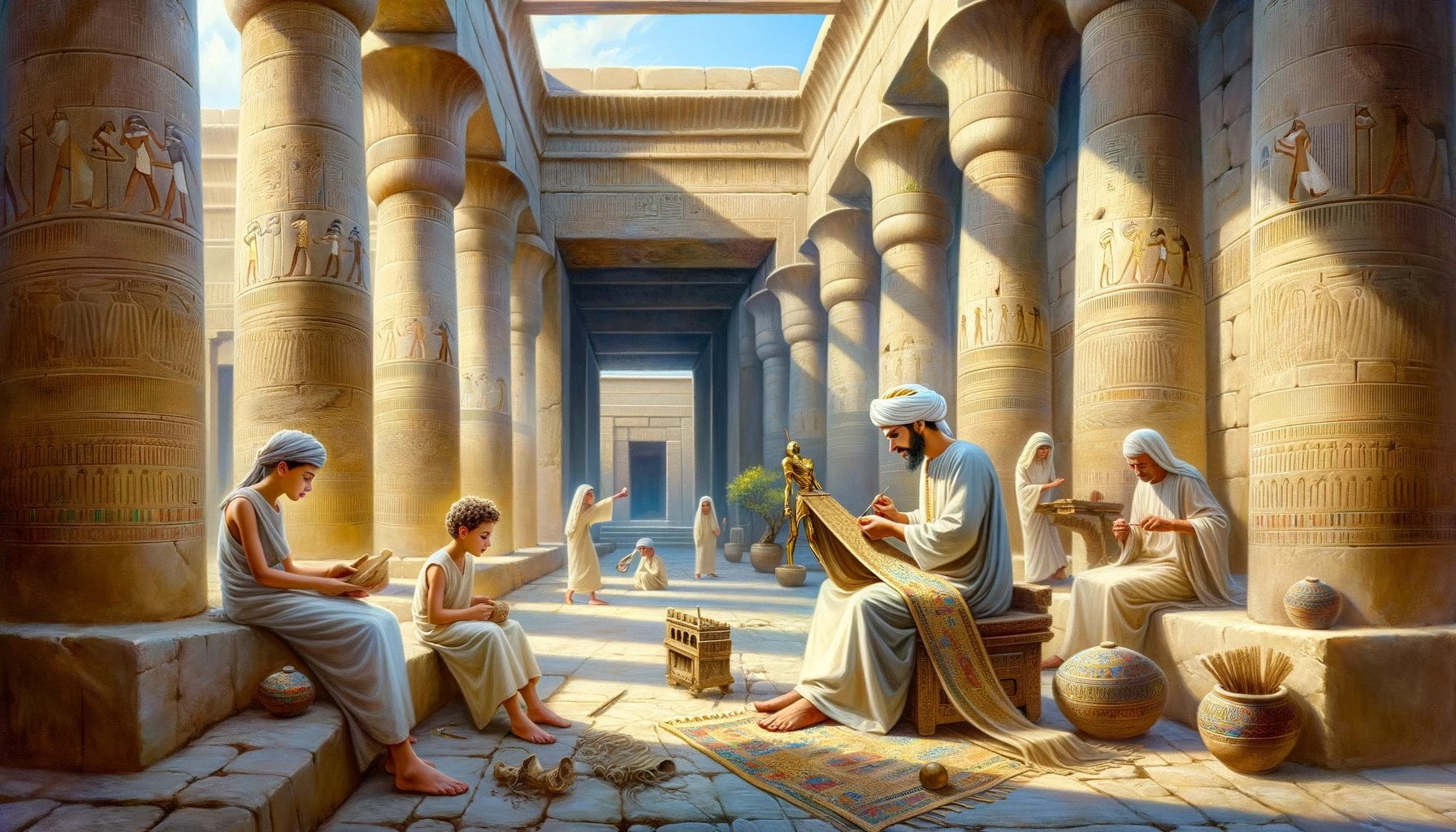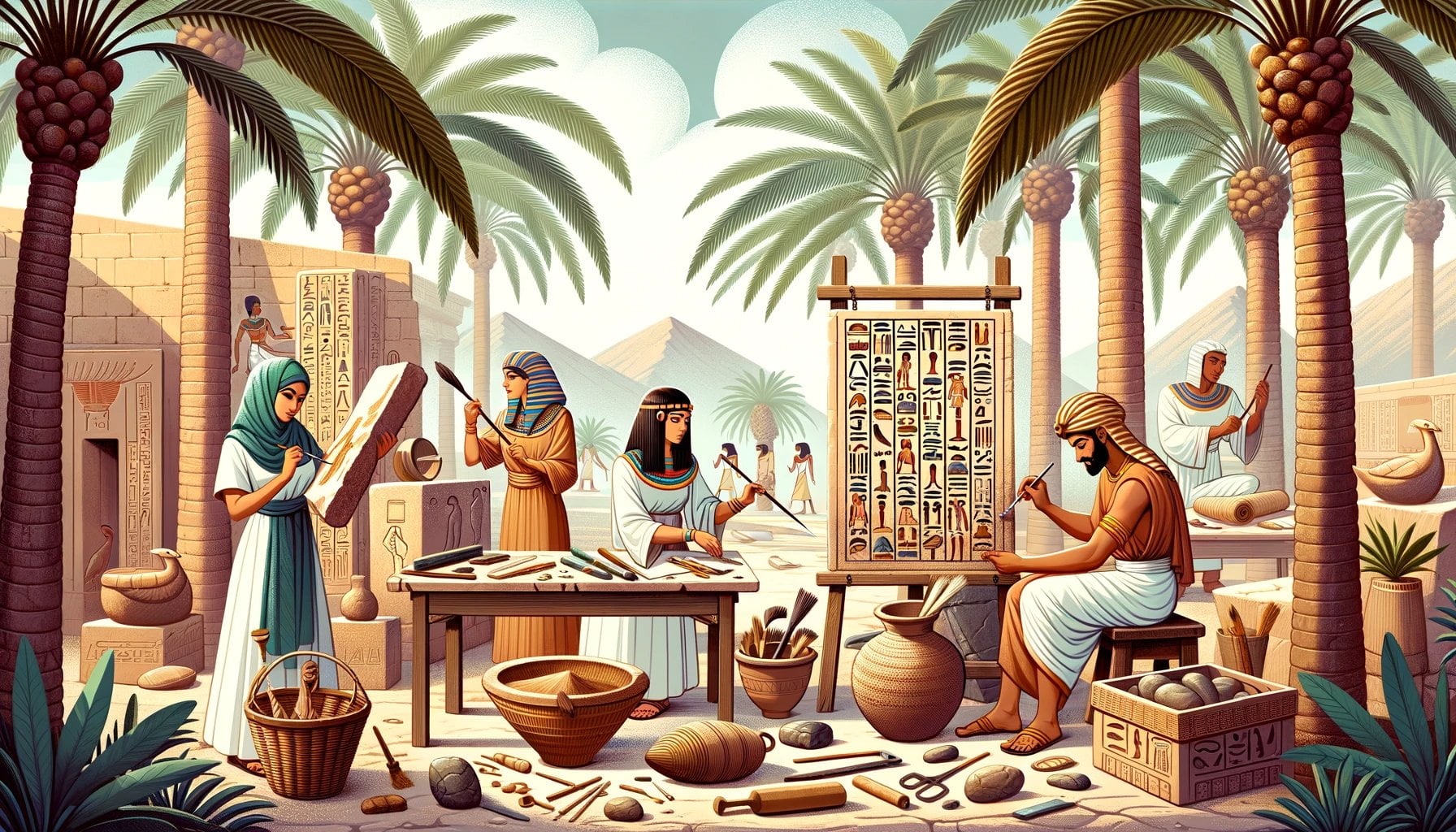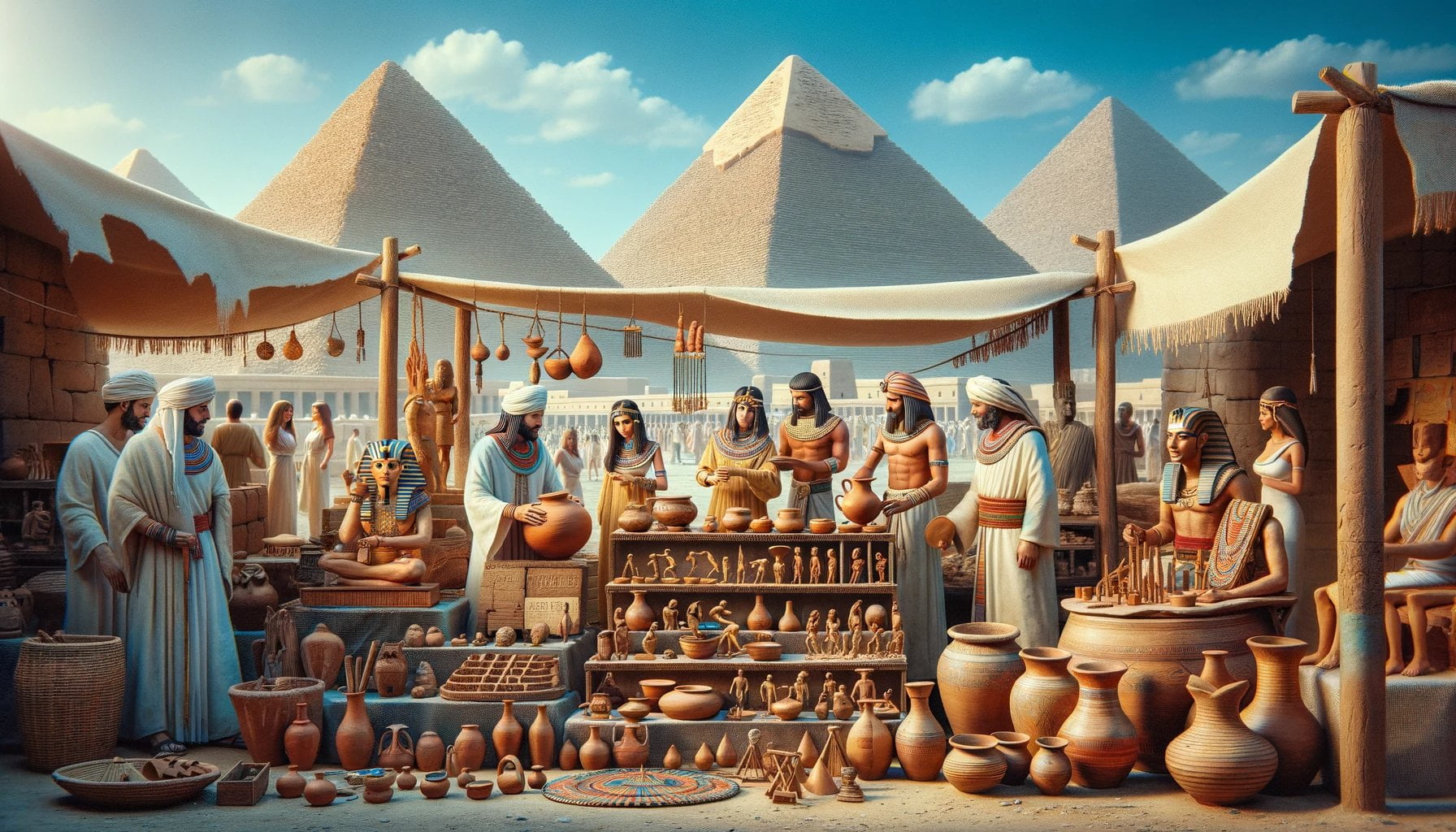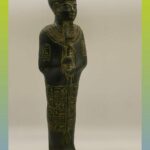Welcome to “Masterful Artisans: Unveiling Ancient Egyptian Craftsmanship” – an unparalleled exploration of the remarkable artisans who shaped the artistic landscape of Ancient Egypt. Delve into the captivating world of ancient Egyptian craftsmen, where meticulous techniques and unparalleled skills brought to life intricate jewelry, magnificent stone carvings, exquisite pottery, and awe-inspiring mural paintings. Embark on a journey that uncovers the cultural context and unravels the rich artistic legacy left behind by these masterful artisans.

Key Takeaways:
- Artisans in ancient Egypt were skilled craftsmen who specialized in various trades such as carpentry, jewelry making, painting, pottery, stone carving, weaving, sculpture, and metalworking.
- They were considered a social class and played a vital role in producing magnificent works of art that symbolize the ancient Egyptian civilization.
- Many artisans were commissioned to build and decorate tombs for pharaohs and officials.
- Egyptian artisans used a wide range of materials including clay, pigments, metals, woods, ivory, bone, glass, flax, reeds, and wax.
- They were renowned for their ability to create intricate sculptures, coffins, boxes, and furniture by piecing together small, irregular pieces of wood.
- The main method of training for artisans in ancient Egypt was likely through apprenticeships, though specifics of their training programs are limited in available evidence.
Artisans in Ancient Egypt
Ancient Egypt’s rich artistic legacy would not have been possible without the skilled artisans who dedicated their lives to their crafts. These highly developed craftsmen were considered a social class and played a crucial role in shaping the vibrant artistic landscape of Ancient Egypt.
The Importance of Artisans
Artisans in ancient Egypt encompassed a wide range of trades, including scribes, carpenters, stonemasons, sculptors, builders, weavers, blacksmiths, spinners, dressmakers, glass-blowers, potters, and metalworkers. Their expertise and mastery of various crafts were unparalleled.
These artisans were the backbone of Egyptian society, as they were able to create magnificent works of art that have transcended time. From intricate pottery and jewelry to magnificent stone carvings and mural paintings, the skilled hands of these artisans brought the grandeur of ancient Egypt to life.
The Crafts of Ancient Egypt
Ancient Egyptian artisans excelled in a wide array of crafts. They could specialize in carpentry, jewelry making, painting, pottery, stone carving, weaving, sculpture, or metalworking. Each craft required meticulous attention to detail and a deep understanding of the materials and techniques involved.
– Carpentry: Egyptian artisans were known for their remarkable ability to puzzle together small, irregular pieces of wood to create intricate sculptures, coffins, boxes, and furniture.
– Jewelry Making: The art of jewelry making in ancient Egypt was highly sophisticated. The artisans skillfully worked with precious metals, gemstones, and decorative beads to create elaborate and ornate pieces of jewelry.
– Painting: Egyptian artisans excelled in mural painting, adorning the walls of tombs and temples with vibrant scenes depicting the lives of pharaohs, deities, and everyday Egyptians.
– Pottery: Pottery played an essential role in daily life, and artisans crafted exquisite vessels of various shapes and sizes using clay and a potter’s wheel. These pots were often decorated with intricate designs and painted with pigments made from minerals and pigments.
– Stone Carving: The art of stone carving was highly admired in ancient Egypt. Skilled artisans would carve statues, sculptures, and reliefs from various types of stone, such as limestone, granite, and alabaster.
– Weaving: The art of weaving was practiced by skilled artisans, who used flax to create fine linen fabrics. These fabrics were then used to make clothing, as well as sails, furniture coverings, and cordage.
– Metalworking: Egyptian artisans were adept at working with various metals, including copper, bronze, and gold. They created intricate jewelry, tools, weapons, and decorative objects using techniques such as casting, filigree, and repoussé.
Apprenticeships and Training
While the specifics of their training programs are limited, it is believed that most artisans in ancient Egypt learned their craft through apprenticeships. Young individuals would study under experienced masters, learning the intricacies of their chosen trade through hands-on practice and guidance.
During these apprenticeships, the aspiring artisans would gain invaluable experience and expertise, honing their skills through repetitive practice and dedication. The mentor-apprentice relationship ensured the continuation of knowledge and the transmission of the master’s craftsmanship to the next generation of artisans.
Legacy and Contributions
The work of ancient Egyptian artisans continues to captivate audiences today. Their masterful craftsmanship has left a lasting legacy, with their creations showcased in museums and admired by people from all over the world. The attention to detail, artistic vision, and technical excellence displayed in their works reflect the sophistication and creativity of ancient Egyptian civilization.
From the grandeur of the pyramids to the intricacy of a finely crafted piece of jewelry, the artisans of ancient Egypt provided an invaluable contribution to the world of art and craftsmanship. Through their creations, they immortalized the beauty and splendor of an era long past, leaving us with a profound appreciation for their skill and dedication.
The ancient temples of Egypt are a fascinating glimpse into the rich history of this ancient civilization. Explore these incredible structures and learn about the mysteries they hold. Discover more about the Ancient Temples of Egypt here.
Types of Artifacts Created by Artisans in Ancient Egypt
Ancient Egypt was a civilization rich in artistic expression and craftsmanship. Skilled artisans played a vital role in shaping the vibrant artistic landscape of this ancient civilization. Through their expert craftsmanship and meticulous attention to detail, these artisans created a wide range of artifacts that continue to captivate audiences today. Let’s dive into the different types of artifacts that were created by artisans in Ancient Egypt.
Types of Artifacts:
- Jewelry: Ancient Egyptian artisans were renowned for their exquisite jewelry-making skills. They crafted intricate pieces using various metals like gold, silver, and copper, as well as precious stones such as lapis lazuli and turquoise. Necklaces, bracelets, rings, and amulets were among the stunning jewelry pieces created by these skilled artisans.
- Pottery: Pottery was another significant craft practiced by artisans in Ancient Egypt. They created beautifully decorated vessels and containers using clay. These vessels served practical purposes and were also used as offerings in religious rituals. Artisans used different techniques like hand-building, wheel-throwing, and intricate decoration to create unique pottery pieces.
- Sculptures: Ancient Egyptian artisans were skilled in sculpting and created magnificent statues. These sculptures ranged from small figurines to grand colossal statues. Sculptors carved statues from various materials, including limestone, granite, and wood. The statues depicted gods, pharaohs, and other important figures, showcasing the artistry and attention to detail of the artisans.
- Mural Paintings: Artists in Ancient Egypt were also proficient in mural painting. They adorned the walls of temples, tombs, and palaces with vibrant and detailed paintings. These murals depicted scenes from daily life, religious ceremonies, and mythological stories. The artistic techniques and use of color in these paintings offer valuable insights into ancient Egyptian culture and society.
- Architectural Structures: Artisans in Ancient Egypt were responsible for constructing impressive architectural structures that have withstood the test of time. These structures included temples, pyramids, tombs, and palaces. The craftsmanship and precision demonstrated in the construction of these architectural marvels highlight the mastery of ancient Egyptian artisans.
- Textiles: Weavers played a significant role in ancient Egyptian society. Both men and women were skilled in weaving fabric and creating intricate textiles. They used materials like linen and wool to produce clothing, household items, and decorative textiles. The exquisite craftsmanship of these weavers is evident in the delicate patterns and designs that adorned the textiles.
Ancient Egyptian artisans’ mastery of various crafts, including jewelry-making, pottery, sculpture, mural painting, architectural construction, and textile weaving, is a testament to their expertise and artistic vision. These artifacts provide valuable insights into the beliefs, daily life, and cultural practices of ancient Egypt.
Key Takeaways:
- Ancient Egyptian artisans created a wide range of artifacts, including jewelry, pottery, sculptures, mural paintings, architectural structures, and textiles.
- Jewelry-making involved the use of metals and precious stones to craft intricate pieces.
- Pottery was created using various techniques and served both practical and ceremonial purposes.
- Sculptors carved statues from materials like limestone, granite, and wood, depicting gods and important figures.
- Mural paintings adorned the walls of temples and tombs, depicting scenes from daily life and religious ceremonies.
- Artisans were responsible for constructing impressive architectural structures such as temples, pyramids, and tombs.
- Weavers crafted textiles using materials like linen and wool, creating clothing and decorative items.
The craftsmanship and artistry of ancient Egyptian artisans continues to fascinate and inspire people around the world, showcasing their mastery of various crafts and their immense contribution to the rich artistic legacy of Ancient Egypt.
Influence of Artisans on the Artistic Landscape of Ancient Egypt
The ancient civilization of Egypt stands as a testament to the ingenuity and creativity of its people. At the heart of this vibrant artistic landscape were the skilled artisans who played a pivotal role in shaping the aesthetic legacy that continues to captivate audiences today. In this article, we will explore the profound influence of these artisans on the artistic landscape of Ancient Egypt and delve into their remarkable craftsmanship and techniques.
Artisans: Masters of their Craft
In Ancient Egypt, artisans encompassed a wide range of trades, including scribes, carpenters, stonemasons, sculptors, weavers, blacksmiths, potters, and metalworkers. Their expertise and mastery of various crafts were unparalleled, setting them apart as true masters of their craft. Through a combination of inherited skills and apprenticeships, these talented individuals honed their abilities to create magnificent works of art that adorned the tombs, temples, and palaces of Ancient Egypt.
A Symphony of Materials and Techniques
Ancient Egyptian artisans employed a diverse array of materials and techniques to bring their creations to life. Clay, pigments, inks, metals, woods, ivory and bone, glass, flax, reeds, and wax were just a few of the materials utilized in their artistic endeavors. Interestingly, even broken pottery and limestone sherds acted as unconventional sketchbooks and notepads for these talented individuals.
From the delicate art of pottery making to the intricate process of jewelry making, every aspect of Ancient Egyptian craftsmanship showcased the immense skill and attention to detail of the artisans. The vibrant colors, meticulous carvings, and exquisite designs exhibited in their works provided a visual feast for the eyes, transporting viewers into the rich tapestry of Ancient Egyptian culture.
The Artistic Legacy: A Lasting Influence
Ancient Egyptian art proved to be highly influential, not just within the borders of Egypt but also across the ancient world. This artistic legacy transcended borders and permeated various other cultures, including Greek and Roman artists. The grandeur and sophistication of the Egyptian artistic landscape served as an inspiration for generations to come.
In ancient Egypt, sculptors carved substitute bodies for tombs, funerary statuettes, and tombstones. The two-dimensional art of the time focused on representational aspects rather than creating realistic vistas. This deliberate emphasis on elements such as communication, display, engagement, and spatial connection with the landscape gave Ancient Egyptian art a unique and captivating character.
Key Takeaways:
- Artisans in Ancient Egypt played a vital role in shaping the artistic landscape of the civilization.
- Their expertise and mastery of various crafts were unparalleled.
- Ancient Egyptian art influenced other cultures, including Greek and Roman artists.
- Sculptors in ancient Egypt carved substitute bodies for tombs, funerary statuettes, and tombstones.
- Two-dimensional art in ancient Egypt focused on representational aspects rather than creating realistic vistas.
- Ancient Egyptian art emphasized communication, display, engagement, and spatial connection with the landscape.
- The art of ancient Egypt has inspired artists throughout history, including those of present-day cultures.
In conclusion, the artisans of Ancient Egypt left an indelible mark on the artistic landscape of the civilization. Their masterful craftsmanship and innovative techniques continue to be celebrated and admired, providing valuable insights into the beliefs, daily life, and cultural practices of this ancient civilization. The influence of these artisans extends far beyond their time, ensuring that their artistic legacy lives on, captivating and inspiring generations to come.
Legacy and Impact of Ancient Egyptian Artisans on Contemporary Art
Ancient Egyptian artisans, with their unparalleled skills and mastery of various crafts, left behind a powerful artistic legacy that continues to impact contemporary art. Their craftsmanship not only shaped the artistic landscape of ancient Egypt but also influenced art movements and practices throughout history. Today, we can still witness the remarkable legacy of these artisans in the works of contemporary artists, as they draw inspiration from the rich artistic heritage of ancient Egypt.
Preserving Ancient Techniques and Styles
The legacy of ancient Egyptian artisans lies in their ability to preserve and pass down their techniques and styles through generations. These techniques, such as stone carving, pottery making, and mural painting, have stood the test of time and are still practiced today. Contemporary artists who are passionate about historical art often pay homage to ancient Egyptian artisans by incorporating their techniques into their own work. This integration of ancient techniques with modern mediums creates a unique and captivating artistic expression.
Symbolism and Iconography
The symbolism and iconography present in ancient Egyptian art have had a profound impact on contemporary artists. The use of hieroglyphs, religious symbols, and mythical creatures in ancient Egyptian artwork continue to serve as a source of inspiration for artists today. By incorporating these symbolic elements into their own creations, contemporary artists not only pay tribute to the mastery of ancient Egyptian artisans but also create a visual language that resonates with viewers on a deeper level.
Influence on Modern Sculpture and Architecture
Ancient Egyptian sculptures, with their striking representations of deities, pharaohs, and important figures, have had a significant influence on modern sculpture. The emphasis on human form, the meticulous attention to detail, and the use of various materials have been adopted and reimagined by contemporary sculptors. Similarly, the architectural monuments of ancient Egypt, such as temples and pyramids, have served as inspiration for modern architects who seek to create awe-inspiring structures that communicate power and grandeur.
Rediscovering Meaning and Purpose
Ancient Egyptian art was deeply rooted in religious and cultural beliefs, and it often served a specific purpose, such as adorning tombs or communicating important stories and rituals. Contemporary artists, in their quest to reconnect with deeper meanings and purposes in art, often turn to the art of ancient Egypt for guidance. By exploring the historical context and the intentions behind ancient Egyptian artwork, modern artists find inspiration for creating meaningful and thought-provoking pieces that resonate with audiences in a profound way.
Key Takeaways:
- Ancient Egyptian artisans have left a lasting imprint on contemporary art through their preserved techniques, symbolism, and iconography.
- Contemporary artists often pay homage to ancient Egyptian artisans by incorporating their techniques into their own work.
- The symbolism and iconography present in ancient Egyptian art continue to inspire artists, who integrate these elements into their creations.
- Ancient Egyptian sculptures and architectural monuments have had a significant influence on modern sculpture and architecture.
- The art of ancient Egypt helps contemporary artists rediscover deeper meanings and purposes in their work.
In conclusion, the legacy and impact of ancient Egyptian artisans on contemporary art are undeniable. Through their mastery of various crafts, preservation of techniques, and infusion of symbolism, these artisans continue to inspire artists around the world. The artistic heritage of ancient Egypt lives on, providing a rich source of inspiration for contemporary art and ensuring that the legacy of these masterful artisans endures.
References:
Ancient Egypt. (n.d.). https://education.nationalgeographic.org/resource/resource-library-ancient-egypt/
Bowman, A. K., Wente, E. F., Dorman, P. F., Samuel, A. E., & Baines, J. R. (2023, September 30). Ancient Egypt | History, Government, Culture, Map, & Facts. Encyclopedia Britannica. https://www.britannica.com/place/ancient-Egypt
Ancient Egypt. (2023, September 27). Wikipedia. https://en.wikipedia.org/wiki/Ancient_Egypt

FAQ
Q1: What were the different types of artisans in ancient Egypt?
A1: Artisans in ancient Egypt included scribes, carpenters, stonemasons, sculptors, builders, weavers, blacksmiths, spinners, dressmakers, glass-blowers, potters, and metalworkers. They were highly skilled in their respective trades.
Q2: What materials did ancient Egyptian artisans use?
A2: Ancient Egyptian artisans used a variety of materials including clay, paints made from pigments, metals, woods (both indigenous and imported), ivory, bone, glass, flax, reeds, and wax. The specific materials varied depending on the craft.
Q3: How did ancient Egyptian artisans learn their skills?
A3: Ancient Egyptian artisans learned their skills through experience and apprenticeships, passing down knowledge from generation to generation. However, there is limited evidence available on the specifics of their training programs.
Q4: What kind of artwork did ancient Egyptian artisans create?
A4: Ancient Egyptian artisans produced a wide range of artifacts including jewelry, sculptures, paintings, and architectural structures. They played a crucial role in producing the magnificent works of art that have immortalized the ancient Egyptian civilization.
Q5: How did ancient Egyptian artisans contribute to society?
A5: Ancient Egyptian artisans were highly valued members of society and their skills and craftsmanship were deeply integrated into the daily lives of ancient Egyptians. They played a significant role in shaping the vibrant artistic landscape of Ancient Egypt.
- Crypto Quotes’ Red Flags: Avoid Costly Mistakes - June 30, 2025
- Unlock Inspirational Crypto Quotes: Future Predictions - June 30, 2025
- Famous Bitcoin Quotes: A Deep Dive into Crypto’s History - June 30, 2025
















